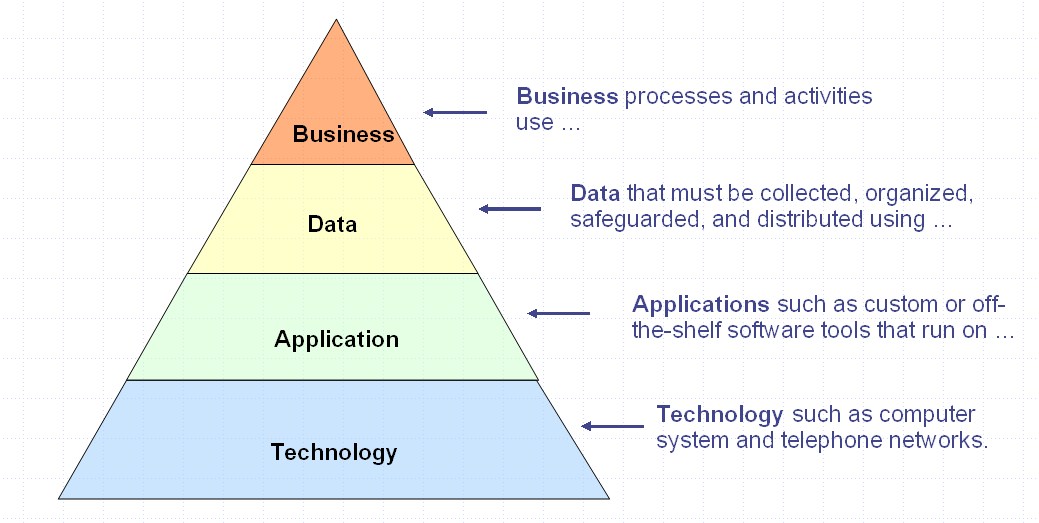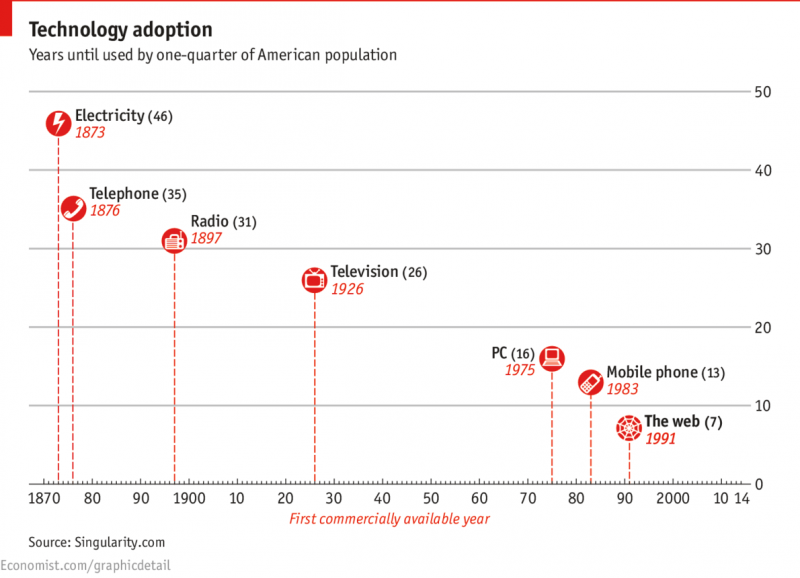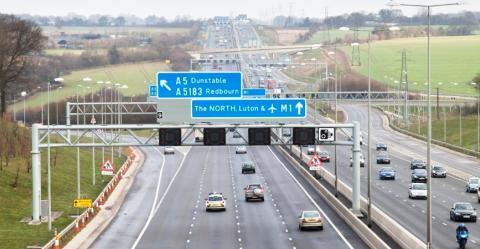Archive for category MPS-EA
Back in the Saddle again…
Digital Disruption, Part 1
This semester (Fall 2017), once again, I will be blogging regarding my reading topics throughout the course. The class focus this time is specifically Enterprise Architecture: Information Technology Architecture.
As I detailed roughly a year ago, Enterprise Architecture (EA) itself can simplistically be considered the intersection of Business, Strategy and Technology. But if we look deeper into the overall concept of EA, we find that it can be easily broken down into smaller domains or layers. As detailed in this diagram created by Niles Hewlett from the USDA Enterprise Architect team back in 2006 (courtesy of Wikipedia), the 4 layers of EA are distinct, yet exist dependent on each other.

Throughout this course, we will dive deeper into each of the layers, exploring how they interact with each other and, more importantly, how different technologies and trends impact the overall architecture and each layer individually as well.
The Fast Pace of Technology Adoption
As we all know and experience frequently, technology is changing at an ever-increasing pace. Today’s hot trends can quickly become tomorrows old news. In considering this challenge, we need to be cognizant that this is two separate issues that compound each other. First, advances in technology itself are accelerating. As expounded in his book, The Singularity is Near, author Ray Kurzweil states, “Evolution (of technology) results in a better next-generation product. That product is thereby a more effective and capable method, and is used in developing the next stage of evolutionary progress. It’s a positive feedback loop” (Kurzweil, 2006). In other words, we are using better & faster tools to design and create better & faster tools. As the end product is improved, this then cuts down on the next stage of development, which in turn shortens the next development phase.
Secondly, adoption of said technology advances are accelerating as well. From end-user consumption of modern technology to the use of technology in business, the differences that we see compared to even 10 years ago is astounding and shocking. As noted by Rita Gunther McGrath, “It took decades for the telephone to reach 50% of households, beginning before 1900. it took five years or less for cellphones to accomplish the same penetration in 1990” (McGrath, 2013). The below chart was assembled by the Economist from data provided in Kurweil’s book. It shows not only the fast adoption of cellphones and the Internet, but other “new” technologies that have had a large impact on society over the past 150 years or so.
As society rapidly adopts technology, this quickly filters into the business world as well. An organization faces an even bigger challenge to be able to integrate the new technology into it’s business practices and strategy without bringing about major disruptions to the operation of the organization. More about that next….
References:
Kurzweil, Ray. (2006). The Singularity is Near: When Humans Transcend Biology. New York. Penguin Books.
McGrath, Rita Gunther. (2013). The Pace of Technology Adoption is Speeding Up. Harvard Business Review. Retrieved August 28, 2017 from https://hbr.org/2013/11/the-pace-of-technology-adoption-is-speeding-up
The End of the Road…
Image Source: Marching In Place
We’ve prepared a solid foundation with a firm cornerstone. We’ve diligently prepared our roadmap and know to look out for important guideposts and standards along the way. We have familiarized ourselves with the rules of the road and have prepared various tools to make sure we are on the right track. As we have come to the end of the road, what lessons have we learned along this journey?
- Expect to fail at the beginning of the implementation. There will always be details that are not obvious and will take some time to uncover.
- In all phases, start general and work toward specific. This will prevent many delays due to a concentration on irrelevant areas.
- Focus on the future-state. Only by having a clear picture of where we want to be, can we succeed and be of value to the organization.
- Having an efficient Roadmap & Plan is important, however having strategic tools such as Guiding Principles, Standards, Governance & Measurement Programs to help make adjustment along the way is more important.
- Agile and flexible is almost always better then rigid and unchanging. The nature of both business and technology nowadays requires the ability to adjust to change rapidly.
Hopefully, by diligently planning our course of action and by being prepared to handle unexpected circumstances, we can successfully navigate to a positive outcome, both for ourselves and our organization.
Navigating the Roadblocks and Detours…
Image Source: Road Signs Direct
So we’ve made our plan, gathered all the necessary supplies, and headed out on our journey. We’ve familiarized ourselves with the rules and know to look for important guideposts along the way. That means everything will be perfect, right?
We’ve jumped in the car and headed toward our destination with our road map in hand. We’ve planned out our stops to resupply and maybe even taken into account a few route options in case we want to make a stop or two along the way. We’ve taken in to consideration the time of day, the weather, and any other factor that may have an impact on our journey. But, as we travel along, we suddenly come across a roadblock. A critical bridge is closed for repair and none of our planning accounted for this detour. Now, our planned road map is no longer relevant and we are in a dilemma. In reality, no matter how foolproof we try to make our plans, there will always be something that is outside of our expectations.
With today’s technology, a GPS system would immediately be able to give us alternate directions to get around our unplanned obstacle. Prior to the advent of GPS technology though, at best you would be able to pull out a physical map and recalculate a new route. Or, if it’s a small detour, there will frequently be signs that direct you to a predesignated route to circumvent the obstacle as well.
All of these potential solutions to the dilemma have one thing on common: an action can be taken at the time of a change of plans. “Coaches spend hours developing strategy before a big game, but cannot predict which tactics they will be using halfway through the game until they see how it develops. Similarly, IT planning time can be well spent understanding how different triggers and results should impact IT’s directions on an ongoing basis. Just as a coach develops options to respond to changing dynamics during the game, EA can plan for options and ensure that flexibility is accommodated to manage a changing environment (Weiss, Rosser and Blanton 2005).” By developing a dynamic strategy to deal with potential changes, the plan becomes agile and responsive, as opposed to being rigid and inflexible.
That strategy could be to develop a tool that will automatically recalculate our intended destination to avoid obstacles. It could be a plan to reevaluate our road map once we meet an obstacle. Or even could be to simply use existing guiding principles to take a brief detour but still be on track to our destination. Whatever method we decide, by developing a strategy beforehand, we can dynamically address issues as they arise and still be successful in reaching our destination.
Image Source: Shutterstock
References:
Weiss, D., Rosser, B., Blanton, C. (2005) Enterprise Architecture Improves IT Planning Synergies (G00130847). Gartner, October
The Measure of a Plan…
Image Source: Touchpoint
I’ve talked a lot about planning for the EA journey as well as the principles and rules that help keep us on the right path. We established our foundation and clearly mapped out the route to get from our starting point to our destination. Yet, how do we know if we are on the right track or have been successful?
Let’s consider the analogy I’ve used in previous posts of a road trip in a car. If we are planning to drive somewhere that will take a few hours, don’t we take care along the way to make sure we are successful? There are tools available to us as the driver that help us to achieve success. The fuel gauge lets us know if we have enough gas to make the trip. The temperature gauge warns us if the car is overheating. The speedometer tells us the speed at which we are travelling, which, in turn, helps us stay within the standards imposed on the road we are traveling. In addition, there are many sensors in the car that will be triggered by certain conditions and alert us as needed.
Image Source: cars.com
The same is true regarding our final destination. Nowadays, we have sophisticated tools such as GPS to help guide us to our goal. Before GPS became common, people would use physical maps to confirm their route and destination. Prior to modern technology, navigation was even more complicated, especially marine navigation. Sailors would need to depend on tools such as charts, compasses and sextants to frequently confirm their current location and make adjustments to their course. Otherwise, they could easily end up being thousands of miles off course.
Image Source: Pinterest
In much the same way, Measurement Programs exist in Enterprise Architecture to “provide the continued demonstration of EA value and the foundation for continuous improvement (Weiss, 2006)”. By establishing relevant metrics of success, the business value of strategic decisions can be effectively measured. This, in turn, allows the organization make better strategic decisions to achieve its business objectives, initiatives and goals. “Linking goals to measures, as well as selecting the metrics that will drive improved performance based on these goals, is the key to successfull EA measurement (Weiss, 2006).”
References:
Weiss, Deborah (2006) Enterprise Architecture Measurement Program, Part 2: Defining What and How to Measure (G00142387). Gartner, September
The Rule of Law
Image Source: osce
Last week I briefly talked about how Guiding Principles and Governance work hand-in-hand to keep Enterprise Architecture on the right course. Guiding Principles act as the guideposts that point us in the right direction at the time of a decision, and Governance acts as our absolute boundary within which we can effectively operate. But what exactly does that mean? Let’s examine the below photo as an example.
Image Source: Road Signs Direct
The analogy between Guiding Principles and guideposts in this case is illustrated by the road signs on the highway. Let’s imagine that my destination is the airport and I am unfamiliar with this area. I know I was supposed to drive on this highway to get to the airport and when I reach this decision point, the sign points me in the right direction. Simple enough. But how is the concept of Governance illustrated by this same picture?
According to The Open Group, “Governance is essentially about ensuring that business is conducted properly (TOGAF Definitions)”. With that in mind, when we re-examine the above photo, there are underlying rules that are in action.
- The drivers stay within a particular lane.
- Everyone on their respective sides of the road is heading the same direction.
- Everyone is driving roughly at the same speed (we hope).
- The drivers stay within the physical boundaries of the highway. There are physical obstructions in place to help reinforce the boundaries.
- Even though it is unseen, it is safe to assume that most, if not all, of the drivers are licensed and insured.
- And most importantly, the vehicles are on the left side of the road!
These rules are dictated by whichever body has authority over that particular section of road. All the rules are in place not only for everyone’s safety, but also to provide the most optimal driving expereince. As soon as one individual driver ignores the rules, for whatever reason (good or bad), all drivers on the highway can be negatively impacted. Hopefully, none of us have had to deal with the experience of someone driving the wrong way on the road, but I can imagine the potential devastation that could happen. By simply having a set of rules that establish boundaries, an optimal environment can be created in which each member can be the most effective. The last example listed above was specifically put there to point out that different environments can have similar or different rules. For the most part, driving in the USA is the same as driving in the UK, with the major exception of which side of the road you drive on. This fundamental difference can have a major impact. Maybe even literally..!!!
References:
TOGAF Definitions – http://pubs.opengroup.org/architecture/togaf8-doc/arch/chap26.html









